Best drum practice pads 2024: Sharpen your chops, anywhere
Play quietly and supercharge your hand technique with our tried and tested pick of the best pads for drummers
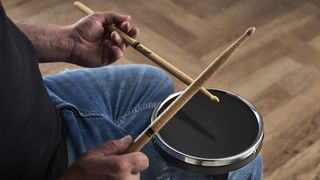
Nothing beats sitting and playing at your acoustic or electronic drum kit, however, in my opinion, the humble practice pad should still be a crucial part of your setup. While playing a full drum kit is your vehicle to playing the grooves and fills that you’ve learned, a practice pad and drumsticks is far more than something to turn to when you need to keep the neighbours happy. In my bid to help your neighbourly relations, I’ve compiled this guide to the best drum practice pads for you, based on pads I've used myself.
By using a pad, you have the opportunity to develop the more mechanical side of playing the drums - developing control, speed, hand technique and muscle memory for sticking patterns in an arguably more focused way - ie. you don't have the kid in a candy store distraction of a full kit. Plus, putting in time on a pad allows you to focus on the nuances of these areas for extended periods without the ear fatigue that even a softly-played acoustic snare drum could induce.
Practice pads are portable, come in a range of sizes, and have different playing surfaces to adjust your feel. The added benefit of being quiet means that you can make the ‘where’ and ‘when’ of your practice time much more flexible. I've got all the info you need to find the right option for you and your budget.
MusicRadar's Choice
My selection covers a range of playing surfaces, pad sizes and budgets. If you’ve used a pad before then the familiar design, feel and sound from practice pads such as the Evans ReelFeel and Vic Firth Hard hitter are most likely what you have in mind. If you have a smaller budget in mind, I would recommend the Evans ReelFeel.
Drumeo’s P4 possibly holds the greatest appeal to kit drummers who want to hold their focus with a varied feel across the same surface. And because of that it's my overall best pick.
Best overall
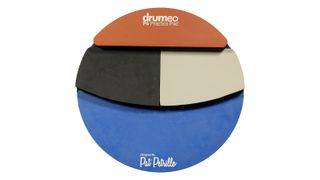
1. Drumeo P4 Pat Petrillo
Our expert review:
Specifications
Reasons to buy
Reasons to avoid
The P4 Practice Pad from online drum education site Drumeo takes playing on a pad to the next level, literally, with its versatile three-layer design.
The Drumeo P4 was designed by New York educator, Pat Petrillo, (and also bears his signature), giving you four different playing surfaces on the same side, and spread over three different levels.
First is the gum rubber section which I found emulates the feel of a tightly tuned snare drum, while the middle level is designed to replicate the feel and rebound of your rack and floor toms. Finally, the pad’s hardest surface on the upper level aims to give you a similar response to a ride cymbal.
As well as a variety of responses from the different zones, I found that the P4’s multi-level layout encourages movement as you would around a full kit, which is perfect if you want to help develop some agility around the kit without being able to sit at one.
It also looks great and isn't so big that it can't slip inside our day bag, or a suitcase.
Best budget
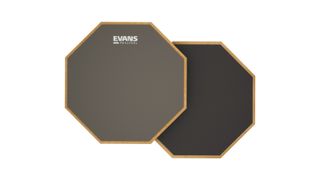
2. Evans ReelFeel Practice Pad
Our expert review:
Specifications
Reasons to buy
Reasons to avoid
When it comes to a no-fuss, simple practice pad, the ReelFeel series from Evans is Classic Coke and it's a pad I've been using on and off for many years. While there are a few different options in terms of sizes and single/double-sided pads, my personal recommendation is the 12” double-sided version.
This octagonal pad consists of a composite wood core, measuring 12” from its widest points on the playing surface, while the extra wooden lip brings the total diameter of the pad to 13”, meaning you can sit it on top of your regular 14” snare drum, or inside your stand’s cradle without any problems.
On one side you get a dense, gum rubber playing surface which provides maximum rebound, while flipping over gives you a recycled rubber surface with less rebound (although I by no means found it to be dead).
Both surfaces are the same thickness, but I found they produced different tonalities when struck. It’s a simple, but not limited, durable pad that will end the search for many players straight out of the gate. It's the cheapest pad in my list, too.
Best compact
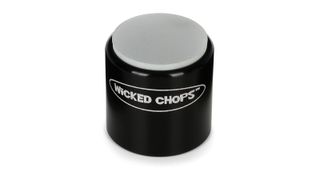
3. Ahead Wicked Chops Practice Pad
Our expert review:
Specifications
Reasons to buy
Reasons to avoid
While Ahead started life as a sub-brand of arrow manufacturer Easton, producing aluminium drumsticks, it has since moved into drum accessories (and even snare drums). The Wicked Chops pad is an innovative, go-anywhere design that you can keep in your stick bag, sling in your backpack or pocket and use to build your chops on the go in the smallest of spaces. At 1.75” diameter, and just 2” high, accuracy is certainly a by-product of using this small pad and I found it really dialed in my precision in a very short time - out of necessity to use the pad more than anything!
There’s a single rubber playing surface which is similar to the gum side of other pads featured in this guide and when not mounted to a stand, the pad sits firmly in place on your desk. However, given it’s dimensions, I don't think the Wicked Chops pad is the perfect choice for warming up on your lap or on a surface that isn’t flat and solid.
That said, for portability when warming up or grabbing your sticks during a break, the Wicked Chops Practice Pad certainly wins for me.
Best for quiet practice

4. RTOM Moongel Workout Pad
Our expert review:
Specifications
Reasons to buy
Reasons to avoid
Unlike many of the best drum practice pads I've included in this guide, the Moongel Workout Pad from RTOM doesn’t feature any rubber playing surfaces at all. Instead, RTOM have made the pad’s playing area from its famous Moogel – the same stuff drummers use for dampening overtones on acoustic drums. The result is a pad that offers a greatly reduced stick rebound – similar to playing on a pillow.
I found that this forces you to use your wrists and arms more, maintaining a fuller grip on the stick to keep the momentum going. It also offers a reduction in acoustic noise due to the soft nature of the gel, so it’s a great choice if you’re looking to build stamina without making prolonged hollow tapping sounds. I found that the volume was significantly reduced compared with my Evans ReelFeel pad and my partner was instantly able to tell the different between the two when playing each pad in an adjoining room.
The Moongel pad can also be mounted to an 8mm cymbal stand thread, and has non-slip rubber on the underside to stop the pad from running away from you. Plus, at 7” in diameter it’s small enough to be easily portable. It’s not a traditional practice pad, but it definitely has its own place in the market.
Best for e-drummers

5. Remo SilentStroke Practice Pad
Our expert review:
Specifications
Reasons to buy
Reasons to avoid
Mesh heads have become extremely common in the last decade thanks to the increased popularity of electronic drum kits, and numerous companies now offer their own mesh-style heads. These take on a similar feel to a traditional drum head and, with a tiny tennis racket-style weave to them, disperse the bulk of the impact noise and resonance you get from striking a traditional drum head.
Of course, you could buy a mesh head and fit it to an existing drum, but that would mean making time-consuming changes unless you have a spare drum to use for this purpose. Likewise, there are plenty of affordable electronic pads equipped with mesh heads, but unless you have one that you’re not using, you’ll be paying extra for the trigger part of the pad. Remo’s Silentstroke mesh practice pad offers a ‘dumb’ pad that will achieve everything you need it to, while remaining portable and perfectly affordable.
One of my favourite features is that the head can be adjusted by using the tensioning screws, just like a regular drum. Plus, like many other pads in this guide, the SilentStroke can be mounted to a cymbal stand via its threaded base or used on a table top without slipping thanks to the non-slip rubber underside.
Overall, the feel is great, and would be particularly suited to drummers who spend a lot of their time playing e-drums.
Best multi-purpose

8. Aquarian Super Pad 14”
Our expert review:
Specifications
Reasons to buy
Reasons to avoid
The Aquarian Super Pad can be used as a standalone practice pad, or as a drum-mounted, noise-reducing pad. The Super Pad also features a closed underside, with a more solid central core. This dual-purpose design gives you some additional convenience in that you can take the pad away and use it on its own when you’re away from your kit, however the Super Pad does not have an adjustable playing surface, which is reflected in my star rating.
The pad remains in place by creating its own vacuum seal against your head, and the resonance is enough to activate the snares and tone/pitch of the drum you use it on, which is a great feature not offered by other pads here.
I found the 14” ‘snare’ version fit all of my regular snare drums like a glove, but there are also 10”, 12”, 13”, 16” and 22” versions for you to outfit your whole kit if required.
Overall, I found the Super Pad’s felt less bouncy than standard mesh heads due to the lack of tension and the absorbent nature of the surface.
A whole kit’s worth will be pricey, but if you’d prefer less rebound than a regular rubber-coated pad or mesh head provides, along with the flexibility of using the pad with or without a drum, for me this is a strong contender.
Best for saving your sticks
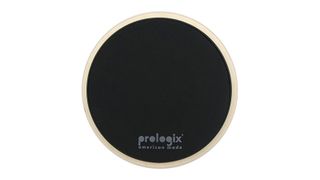
7. ProLogix Blackout
Our expert review:
Specifications
Reasons to buy
Reasons to avoid
ProLogix produces some of the most desirable-looking practice pads on the market, and across its busy product line there are plenty of options to choose from. The Blackout series offers the most ‘dead’ feel of its standard pads, with a thick yet soft playing surface that will force you to manipulate the sticks for each stoke while offering a reduced volume level compared to harder surfaces.
The chunky neoprene top is mounted to the CNC-cut Baltic birch base, giving you a sturdy feel along with a countersunk rim. This allows you to practice some additional stick techniques such as rimshots, and it’s designed not to chew up your sticks. Turn the pad over, and the thinner, non-slip base rubber also doubles as a second playing surface, giving you greater rebound along with a louder, more solid tonality.
The Blackout is available in three sizes – but I'm recommending the 8” version here as I feel the solid construction and thick playing surface strikes a great balance between portability and playing response. It’s a quality pad, but the price is still competitive.
Best for marching
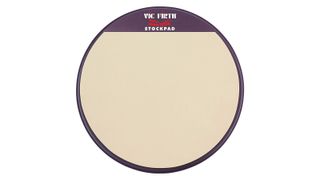
8. Vic Firth Heavy Hitter Stockpad
Our expert review:
Specifications
Stick giant Vic Firth’s Heavy Hitter pads were first designed by hand technique guru/drumline monster/educator, Bill Bachman, and a quick glance at any one of Bill’s videos online should be enough to confirm that you’re in good, er, hands with this practice pad.
The Heavy Hitter is available as two models: Slim or the Stockpad which I’ve chosen as my recommendation. While the Slim model’s reduced thickness makes it slightly more portable, in reality we’re talking about a difference of a couple of mm on the depth of the playing surface and a few grams lighter overall. While that adds up to a slightly less bulky pad, I think the tonal difference between the two is actually quite large, with the extra thickness of the Stockpad’s gum rubber surface producing a lower-pitched, warmer stick sound.
Once again, the Stockpad is 12” in diameter with a wooden base, and the underside of the pad is fitted with a non-slip rubber surface to help fix the pad in place. Vic Firth also produces Mylar (drum head material) laminates to attach to the Stock Pad, giving you an even more realistic feel.
How to choose the best drum practice pad for you
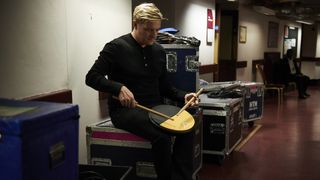
A practice pad is essential for any drummer who can't practice regularly on a full kit, or any player who is serious about developing their hand technique. There are a few key criteria you should consider when picking up a pad:
Playing surface
This will govern how your stick rebounds when you strike the pad, as well as the type of sound you’ll create. At their most basic, practice pads will commonly offer one (single-sided) or two (double-sided) playing surfaces, with a wood or plastic core. The playing surfaces usually incorporate a dense, hard rubber surface or softer, less responsive side. The first is designed to replicate the bounce of a tightly-tuned drum head, throwing the stick back quickly after each stroke and will usually produce a dead-sounding thud, great for learning to manipulate the rebound with finger control.
Flip the pad over, and you’ll usually have a more cushioned, less responsive side that doesn’t give as much rebound – better suited to developing techniques that don’t rely on utilising rebound (such as your wrists). In the case of single-sided pads, you’ll need to choose the type of response you’re looking for.
While these playing surfaces are the most common, there are also mesh heads – the same as you’ll be used to from an electronic drum setup, gel pads which are closer to playing the ‘dead’ side of a rubber pad, and in some cases, pads with multiple ‘zones’ of different material on one side.
Size
Your next important decision is pad size. If accuracy and convenience are important, then choosing a smaller 2”-8” pad will allow you to set up virtually anywhere, with features such as cymbal stand threads and non-slip bases commonly available.
On the other hand, if you’re looking to replicate the feel of playing on a drum, or want to sit the pad in a snare stand cradle or on top of a drum, then larger pads are also available.
Mounting
Do you want to mount your pad off a stand, or will you mostly be practising on your lap or other flat surface? Some pads offer a threaded base for mounting on a cymbal stand, where others may include a strap for attaching to your thigh. Other pads offer neither. You'll need to consider your current and future usage before you commit to one particular model.
Build quality
We know drummers who have been using the same pad for decades - just look at the age of the pad session drummer Craig Blundell is using in the image above. We couldn't believe it when he showed us! - and that's all down to the build quality. Practice pads are basic bits of kit, and when built using quality materials, could potentially be a one-time investment that lasts your entire playing life.
Cost
There's no such thing as a bad practice pad these days, and a budget pad should deliver many years of happy chop-building. But the old adage of 'you get what you pay for' still stands and the more you spend the better the components and features you'll get.
FAQs
Why do I need a practice pad?
MusicRadar's got your back
As far as drummers are concerned, those who put in the practice on a pad will refine and maintain their technique quicker and get more out of their playing when they sit behind a kit.
All of the drummers on the MusicRadar spent almost as much time on a pad as they did on a kit in the early days of learning, and to this day still bust out the pad on a regular basis, sit in front of the TV and fine-tune those rudiments to keep our hands in shape.
If you're lucky enough to have your own space to play at a full acoustic or electronic kit, then a practice pad isn't such an essential purchase. However, if you're away from home a lot, don't have access to a kit, or you live in a built up area where there are noise limits, a practice pad is the easiest way to continue working on those all-important skills, even when a kit isn't available.
Can I make my own practice pad?
If budget is super tight then yes, there are plenty of alternatives out there that won't break the bank. From using a bed pillow (either at home or in a hotel room - don't forget to pack your sticks), to a mouse pad, or any surface that offers the right level of rebound, you can find ways to practice with spending much, or in some cases anything, at all. Our only caveat is that you ensure whatever you're practicing on won't be damaged after a pounding from your sticks.
Alternatively, you could fashion your own for not much money using a cheap wooden chopping board (ideally round), and a rubber or neoprene material (like a mouse mat). Glue them together and, hey presto, your very own DIY practice pad!
Should I get a full practice pad drum set?
Set ups like the DW Complete Practice Kit are great, but they defeat the object of a practice pad being compact and portable. We've seen plenty of full practice rigs backstage during major tours, which makes sense for pro drummers warming up ahead of their set, but unless you have the space for yet another bit of gear, they're potentially overkill for most 'normal' drummers who have regular access to a full acoustic or electronic kit.
How we choose the best drum practice pads
Here at MusicRadar, our core team and the freelance writers who contribute to the site are experts in their field, with many years of playing, creating and product testing between them in many specialist areas, from recording, to live performance and everything in between.
Amongst the team is a small but passionate group of drummers, who have played most of the drum gear and accessories that have been launched over the last 20 years.
We live and breathe everything music gear-related, and we draw on this knowledge and experience of using products in live, recording and rehearsal scenarios when selecting the products for our buyer's guides.
When choosing what we believe to be the best drum practice pads on the market for this guide, we combine our hands-on experience, user reviews and testimonies and engage in lengthy discussions with our editorial colleagues to reach a consensus about the top products in any given category. Our combined years of experience means we can give accurate and expert perspectives on the products we consider.
Why trust us:
☑️ MusicRadar established in 2007
☑️ Over 5,000 reviews on-site, including drum kits, services and drum accessories
Find out more about how we test music gear and services at MusicRadar.
Latest updates
Recent updates
30/08/24 This guide had not been updated in a while, so we've given it a lot of love. Starting off with sense-checking all the products entries, we ended up removing the RTOM Black Hole as we decided it duplicated the offering of the Aquarian Super Pad, which is a product we think is superior. We also gave the remaining product suggestions a 'best for' label to make it clear the use-case for each product. Finally, we overhauled our buying advice and FAQs to answer all the burning questions anyone might have about practice pads.
Get the MusicRadar Newsletter
Want all the hottest music and gear news, reviews, deals, features and more, direct to your inbox? Sign up here.

I'm a freelance member of the MusicRadar team, specialising in drum news, interviews and reviews. I formerly edited Rhythm and Total Guitar here in the UK and have been playing drums for more than 25 years (my arms are very tired). When I'm not working on the site, I can be found on my electronic kit at home, or gigging and depping in function bands and the odd original project.